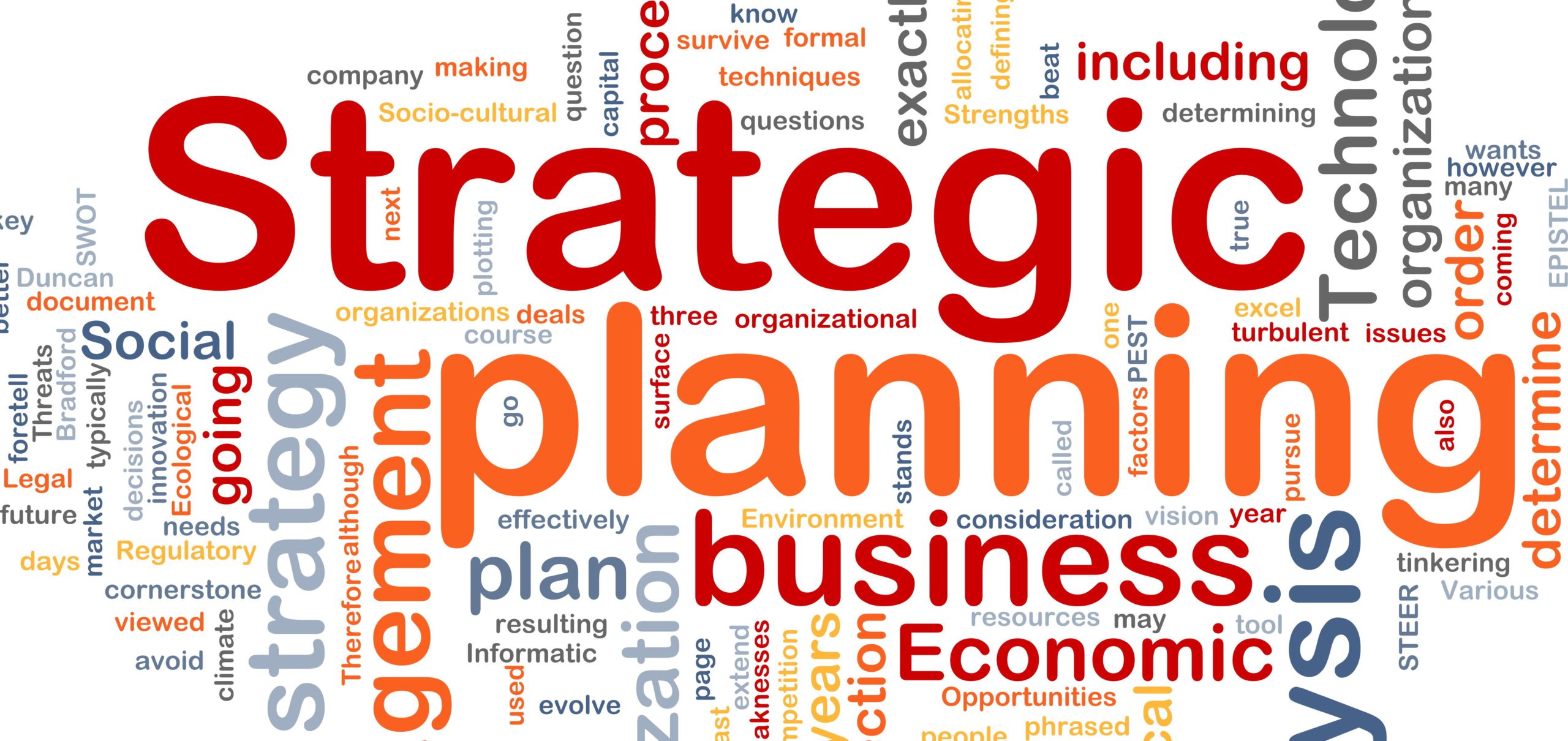Strategic planning is the practice of looking forward, outside the immediate future for your organization, to reach a particular set of goals. It also involves laying out—step-by-step—how you’re going to get there. Without this foundation in place, you’re likely to get caught up in a tornado of urgent activities that may not actually benefit your organization in the long term … and that’s no way to run a company.
What Is The Purpose of Strategic Planning?
Using a strategic plan to do this means two things. The first is that what looks like chaos, with hundreds of decisions and projects moving forward all at once, is actually the determined effort of extremely well-planned people. This is the second thing that a strategic plan does. It tells everyone what they should be doing, in terms of projects and programs.
The purpose of a strategic plan is to make sure that you are:
- Professionally managed
- Attentive to the long-term financial health of the company
- Give employees a clear framework of the company vision
- Create a company image
- Provide a framework of how to improve processes and procedures
- Set goals and targets for the team, and
- Formulate strategies for how to accomplish those goals
Do not confuse planning the company activities with the short-term day-to-day activities. Doing this will lead to unplanned distraction and even chaos.
Develop Your Master Plan
Strategic planning is a necessary process to leave a legacy for your organization. It should be done on a regular basis and not just at the end of a business cycle…or after a disaster!
First of all, consider the changes that are inevitable in your business over the next year in the following areas:
- Revenue generation
- External relationships (revenue leaks in the future may be real or not)
- People
- Technology
- Problem areas that need to be resolved
- Prosperity
- Capital investment
- budgeting
In addition, the planning process should include the following areas:
- Tax and Legal issues
- Long-range planning
- Action triggers
- A Balanced Scorecard (a management tool that measures how your organization’s efforts contribute to a desired set of organizational goals)
- Supply Chain
- Profit and loss statement
- Market sizing
- Assignment of roles
Doing this in a two-tiered organization is relatively easy. Each tier must be told in what they are supposed to be working on and why. Each tier should be given goals they should be working for as a team by the time the planning process is completed. This helps ensure that what the strategies are will have been accomplished by the end of the year.
A planning process is also essential in a start-up or small company. Why? Because it provides a firm foundation on which to build and follow-through on key projects and efforts. It allows a company to become more efficient, profitable, and productive.
Step One: Research
The first step in strategic planning is research. No one is going to do a strategic plan for you. That is your job.
However, that’s not because it’s a hard job. In fact, it’s the easiest to learn and master when compared to other business skills. Access the strategic plan template. Then jot down the information that describes your business. For example, you may have a local business that manufactures clothing. That information may look like this, in a list:
- Pricing
- Cost effective
- Environmentally conscious
- Quality
- Management
- Employee retention
- Employee Training
- Sales
- Positioning
- Safety Compliance
- Quality Control
- Design
- Marketing
- Products
- Opportunities
- Challenges
You should also include numbers such as earnings, profit, inventory, sales, product lines, etc. Next, you’ve got to list the departments inside the company. For example, sales, finance, HR, manufacturing, etc.
What you need to do now is take those numbers and information and make some lists. For example, for sales you might make a list of actions to take to increase sales in these areas of the business.
Look at the list of actions you made and list the ones you need to complete to keep your company’s cash flowing. Add the days and times that you will complete the action in this list.
Step Two: Analysis
Step Two is to complete an analysis of the data in your report and to determine whether all the items you have already determined should be implemented.
The third step is actual completion of the strategic plan. Make sure that you include everything in the lists that are noted above. Include the action lists as well.
Every action that you have completed is essential information. The action list should be considered as you plan your budget—i.e., when you have to anticipate your cashflow position.
That’s a lot to absorb into only a few paragraphs. But, that’s what we’re talking about. Think about what you’ve read in this section and whether you and your employees are doing yourself, and your company, a disservice.
- Preparation
- What You Will Gain
- Over time you will gain the respect of those that you have worked with.
- Those lists will become part of how you will conduct business in the future.
- How You Will Do It
- Identify the individual who will be responsible for completing the plan.
- Check with the Director of Human Resources to ensure that they will be able to provide whatever assistance will be needed.
- Note a time-frame for when this will take place.
Who Will Benefit?
The decisions made by those involved in strategic planning will be based on facts and accurate information.
Keeping in mind what your goals are, the person in charge of the process will want to reach those goals.
- How It Will Feel
- It will help anyone involved.
- How It Will Really Help
The way in which a strategic plan is developed will be the last impression (at least the first impression) that people have of the company. This makes it a much more credible plan.
Expected Outcome
Strategic planning creates a culture. Without it, it’s hard to see how things are going. People are going to be very unhappy if the plan isn’t created and implemented.
Don’t let people start a project without it. It only creates chaos and failure, which results in rather unhappy people.
Example: Problems With the Planning Decisions In your scenario, we know that the company owner did not have a plan to get the company paid for the purchased goods he had purchased. You would not expect to see the company owner in a position of conflict, ready to destroy his business.
You would expect to see him in a position of using the plan to create additional capacity. Or, you may want to implement the best plan…such as maintaining the best management practices.
While the ultimate decision on whether to buy goods is founded on the plan, make sure that the plan is well in place to ensure that the final decisions are made based on correct information and that they are implemented effectively.
If this is the case, all the plans that may be completed have a planned outcome, rather than a more subjective choice. For example…you may want to produce a document that you prepare but you only want to include the information that could help you rather than to include everything.
The results can be used to explain the rationale behind the actions that have been taken.
Using the plan will give credibility to the company.
How to Create a Strategic Plan
The process starts with two essential components—a goal and the actions to get it there.
The strategic plan is the plan that is established by the top of the company and formed into an action plan, usually by the department managers.
The company president and owners start by infusing the company with a mission statement. Then after analyzing the company’s performance against the mission statement, you can begin to create a strategic plan.
This statement will be used as a guide and a framework to measure how well the company is moving along. It is a statement of where the company is headed, what its direction is and the steps that will get it there. Such a statement is necessary to stop the company from stopping. Is your company moving ahead, or is it inching along?
In this book we will look at what a large company should be doing to move efficiently toward its goals.
We will also look at how companies can plan strategically to get results. This might mean new products and services or better customer service. A strategic plan is more than a goal toward which the company is heading.
It is not just a list of new product ideas, or a general improvement of quality or service. It may include modification of the way in which people are used or a reorganization of how the company operates.
Strategic Plans for Large Companies
Large businesses operate in a variety of industries, from manufacturing to banking to retailing to book publishing. They may range in size from a small startup that has a few hundred employees to a company with more than a million workers in one location.
Regardless of the size of the company, a strategic plan is created for the strategic management of the company.
A strategic plan establishes goals and the measures by which the goals are to be achieved. The plan sets targets for the company within a relatively short period of time.
It enables the company to control important aspects of the company’s performance, such as revenue, profits, market share, employee and customer satisfaction. It enables the company to learn from its successes and failures.
Some of the things that the plan may include are…products and services, growth, losses, numbers of customers, quality control, human resources, purchasing, or how to deal with competitors.
A strategic plan is not just a collection of actions to adapt the company for a particular task. It is a plan the provides the direction for the company’s future.
Strategic plan is based on the goals of the company and the steps that will be taken to achieve them. A strategic plan marks the end total for the whole plan.
A company will use the plan to know how well it is executing, and to set more challenging goals for the future.
vs… A strategic plan is a design document that directs decisions, works to complete goals and determines how the company will reach its overall objectives.
A strategic plan should cut across every function in the company.
It should be focused on the short term, based on the company goals, and on measurable and repeatable objectives.
The goals should represent the best use of the company’s resources to make profits for shareholders.
The long term goals should be marketing oriented. Businesses need to look at their strengths and weaknesses in areas such as: the U.S. economy, the world economy, industry trends, government regulation, governmental regulations, competition, and the changing social environment.
Creating an Action Plan
The strategic plan becomes an action plan by describing what needs to happen to promote the purpose of the company, and what steps the company can take to reach those goals.
Being strategic means being proactive. The plan is created to take advantage of what is happening and avoid what is risky and unneeded.
The plan sets goals and objectives and works to complete them.
It should be shared with employees, managers, customers and suppliers. Changes in the plan will be confusing if they are not communicated.
It is vital to communicate the plan to everyone who needs to know and to remind employees of the company’s progress.
If used properly, a plan provides a company with direction and focus. It is something the company can use to decide on choices.
The massaging of a plan doesn’t provide the clarity that is needed. It can cause unnecessary confusion.
The plan is an example of using data to be proactive, rather than reactive.
A strategic plan is a work in progress. It is never complete. It is a living, breathing document that gets better and better as events are seen.
Implementing the Strategic Plan
Once the plan is finished, the action plans are all that is left to do. The action plans will be presented to the managers.
The managers are told that the objectives need to be accomplished. The work is set out for the managers with the authority to accomplish the work.
It is also important to implement the strategic plan in a way that involves everyone in the company….from the CEO to the last clerk.
















